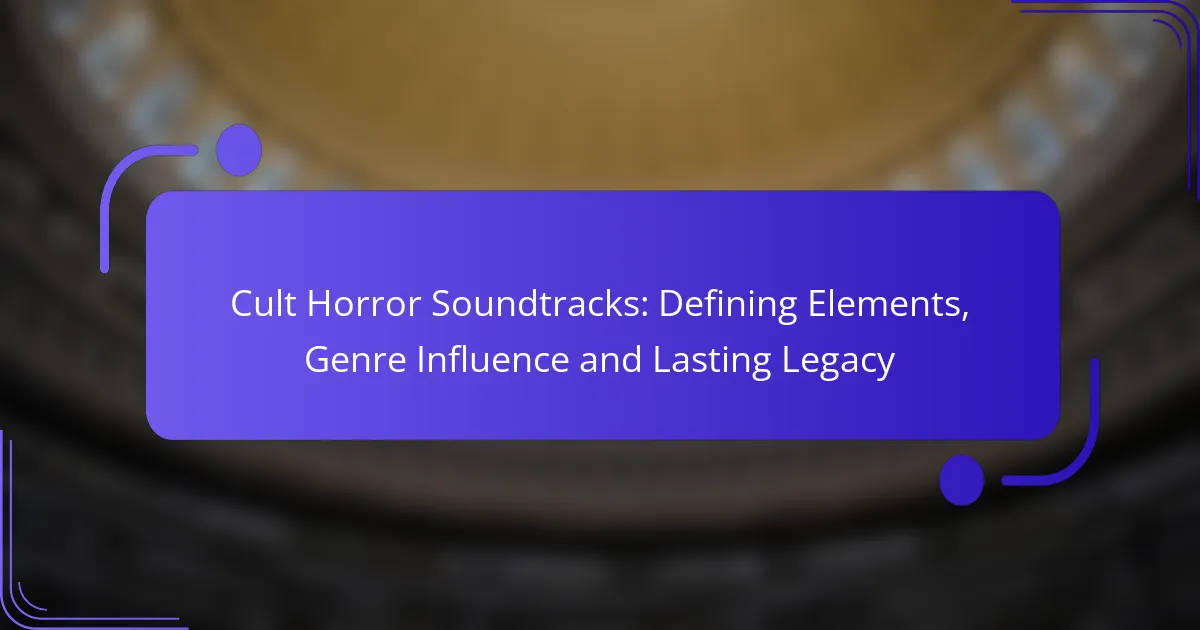Cult horror soundtracks play a crucial role in shaping the genre by using specific musical elements to evoke fear and tension. With their atmospheric compositions, dissonant themes, and unique instrumentation, these soundtracks enhance the visual storytelling and create iconic moments that resonate deeply with audiences. Their innovative sound design and unsettling melodies leave a lasting legacy, influencing both filmmakers and fans alike.
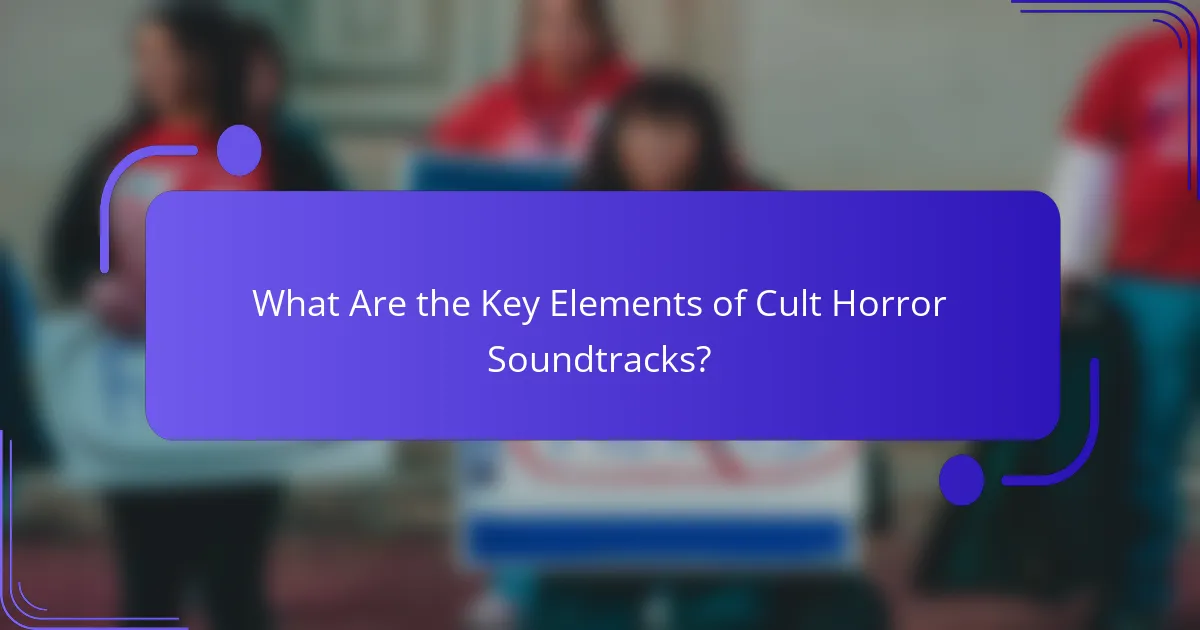
What Are the Key Elements of Cult Horror Soundtracks?
Cult horror soundtracks are characterized by their ability to evoke fear and tension through specific musical elements. Key components include atmospheric composition, dissonance, iconic themes, unique instrumentation, and their integration with visual storytelling.
Atmospheric Composition
Atmospheric composition in cult horror soundtracks creates an immersive experience that enhances the film’s eerie ambiance. Composers often use layered sounds and ambient noise to build tension, making the audience feel unsettled. For instance, low-frequency drones or subtle background noises can evoke a sense of dread without being overtly aggressive.
Effective atmospheric soundtracks often employ minimalistic approaches, allowing silence and space to amplify the emotional impact. This technique can make the audience more susceptible to sudden scares or shocking visuals.
Use of Dissonance
Dissonance plays a crucial role in cult horror soundtracks by creating a sense of unease and unpredictability. Composers frequently use clashing notes or unconventional chord progressions to provoke discomfort, which enhances the horror experience. For example, a simple melody can be transformed into something unsettling through the introduction of dissonant harmonies.
Utilizing dissonance effectively requires a balance; too much can overwhelm the listener, while too little may fail to elicit the desired emotional response. A well-placed dissonant chord can serve as a powerful tool to heighten tension in key scenes.
Iconic Themes
Iconic themes are memorable musical motifs that become synonymous with specific horror films. These themes often encapsulate the essence of the story or the central antagonist, making them instantly recognizable. For instance, the theme from “Halloween” by John Carpenter is a prime example of how a simple melody can evoke fear and anticipation.
Creating an iconic theme involves crafting a melody that resonates emotionally with the audience. Repetition and variation of the theme throughout the film can reinforce its significance and enhance the overall impact of the soundtrack.
Instrumentation Choices
The choice of instruments in cult horror soundtracks significantly influences the mood and tone. Unconventional instruments, such as theremins or prepared pianos, can produce eerie sounds that align with the horror genre. Additionally, traditional orchestral instruments may be used in non-traditional ways to create unsettling effects.
Composers often blend electronic sounds with acoustic instruments to create a unique sound palette. This fusion can enhance the otherworldly feel of the soundtrack, making it more engaging and memorable for the audience.
Integration with Visuals
Effective integration of soundtracks with visuals is essential in cult horror films, as music can amplify the emotional weight of scenes. Composers must consider timing and synchronization to ensure that musical cues align with visual elements, enhancing the overall storytelling. For example, a sudden musical crescendo can coincide with a jump scare, maximizing its impact.
Moreover, the use of silence or minimalistic sound during key moments can create a stark contrast that heightens tension. Understanding the relationship between sound and image is crucial for creating a cohesive and impactful horror experience.
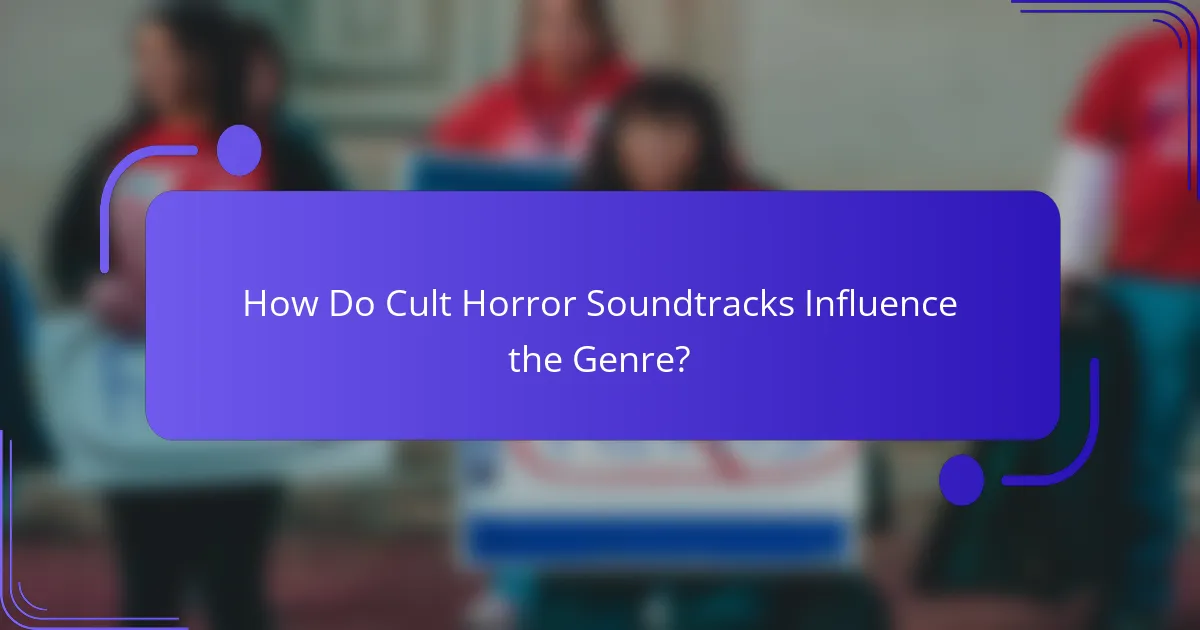
How Do Cult Horror Soundtracks Influence the Genre?
Cult horror soundtracks significantly shape the genre by establishing mood, enhancing tension, and creating iconic moments that resonate with audiences. These soundtracks often utilize unique instrumentation and unconventional techniques to evoke fear and intrigue, ultimately leaving a lasting impact on viewers’ experiences.
You can explore more about these impactful scores in cult horror movie soundtracks.
Setting the Tone
Soundtracks are crucial for setting the tone in cult horror films, as they create an auditory backdrop that aligns with the visual elements. For instance, eerie melodies or dissonant chords can immediately signal a shift into horror, preparing the audience for unsettling events. Composers often experiment with unconventional sounds, such as distorted instruments or ambient noise, to enhance the film’s atmosphere.
Classic examples include the use of synthesizers in films like “Halloween,” where the minimalist score establishes a sense of dread. This approach allows filmmakers to manipulate viewers’ emotions from the very start, making them more susceptible to the narrative’s shocks.
Enhancing Suspense
Suspense in horror films is often heightened through strategic use of soundtracks. Composers build tension by gradually increasing volume or tempo, creating an anticipatory feeling that keeps audiences on edge. Techniques such as sudden silences or unexpected musical shifts can amplify moments of fear, making the eventual scares more impactful.
For example, in “Psycho,” Bernard Herrmann’s score employs sharp strings to punctuate moments of terror, effectively enhancing the suspense during key scenes. This manipulation of sound keeps viewers engaged and invested in the unfolding drama.
Creating Memorable Moments
Memorable moments in cult horror films are often defined by their soundtracks, which can transform a scene into an unforgettable experience. Iconic themes or motifs become synonymous with specific films, allowing audiences to recall them long after viewing. A well-composed score can elevate a simple scene into a powerful emotional experience.
Consider the haunting theme of “The Exorcist,” which has become a cultural touchstone, instantly recognizable and associated with horror. Such themes not only enhance the film’s identity but also contribute to its legacy within the genre.
Impact on Audience Perception
The impact of soundtracks on audience perception is profound, as they shape how viewers interpret the narrative and characters. A chilling score can lead audiences to perceive a character as sinister or a situation as dire, influencing their emotional responses. This psychological manipulation is a key element in horror storytelling.
For instance, a soundtrack that features unsettling sounds can make a seemingly mundane setting feel threatening. This shift in perception can enhance the overall horror experience, making audiences more likely to engage with the film’s themes and emotions.
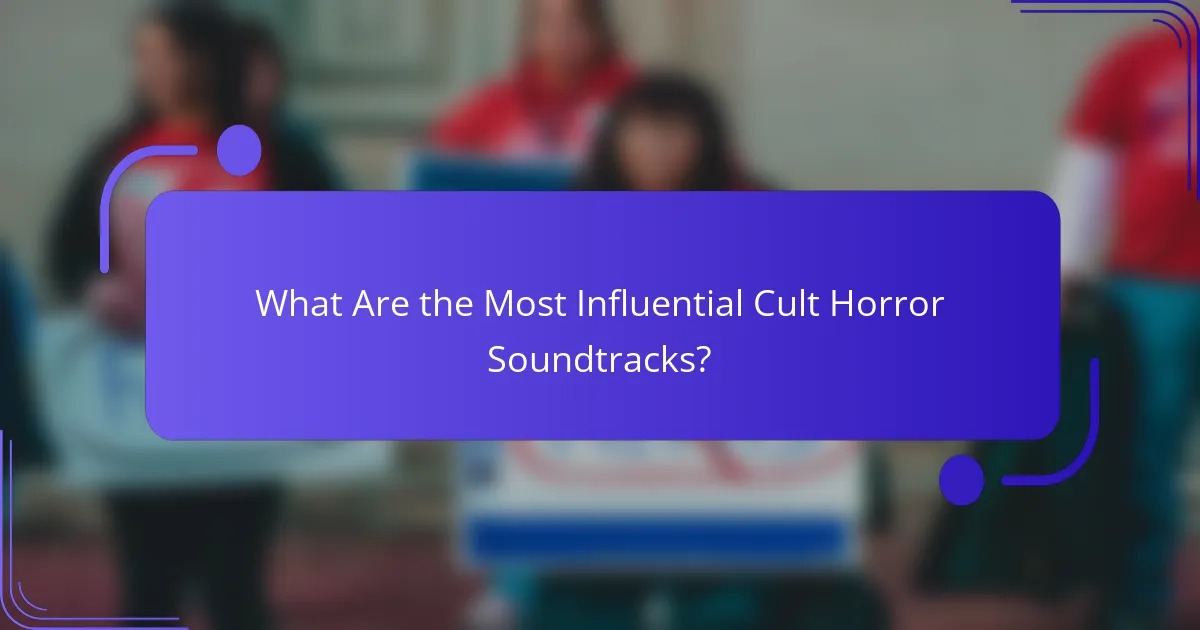
What Are the Most Influential Cult Horror Soundtracks?
The most influential cult horror soundtracks are those that have significantly shaped the genre and left a lasting impact on audiences. These soundtracks often blend unsettling melodies with innovative sound design, enhancing the overall atmosphere of the films they accompany.
John Carpenter’s Halloween
John Carpenter’s score for “Halloween” is iconic for its minimalist approach, relying heavily on synthesizers to create tension and fear. The main theme, characterized by a simple yet haunting melody, has become synonymous with the horror genre and is often imitated.
This soundtrack demonstrates how effective repetition and a limited palette can evoke dread. The use of a steady pulse in the music mirrors the relentless pursuit of the film’s antagonist, enhancing the viewer’s anxiety.
Wendy Carlos’ A Clockwork Orange
Wendy Carlos’ work on “A Clockwork Orange” merges classical compositions with electronic sounds, creating a unique auditory experience that complements the film’s themes of violence and societal control. The juxtaposition of familiar classical pieces with unsettling electronic elements challenges the audience’s perceptions.
This soundtrack showcases how music can manipulate emotions and perceptions, using familiar tunes to create discomfort. Carlos’ innovative techniques have influenced many filmmakers and composers in the horror genre and beyond.
Goblin’s Suspiria
Goblin’s score for “Suspiria” is a masterclass in blending progressive rock with horror elements, featuring eerie vocals and complex rhythms. The music plays a crucial role in establishing the film’s dreamlike and nightmarish atmosphere, making it a standout in cult horror soundtracks.
The use of dissonance and unconventional time signatures creates a sense of unease, enhancing the film’s visual horror. Goblin’s work has inspired countless artists and remains a benchmark for soundtracks in the horror genre.
Bernard Herrmann’s Psycho
Bernard Herrmann’s score for “Psycho” is renowned for its string-heavy composition, particularly the infamous shower scene music, which has become a cultural touchstone. The sharp, staccato notes evoke a visceral reaction, perfectly aligning with the film’s shocking moments.
This soundtrack illustrates the power of music to heighten suspense and emotion. Herrmann’s techniques have influenced generations of composers, making it a pivotal reference point in the study of horror soundtracks.
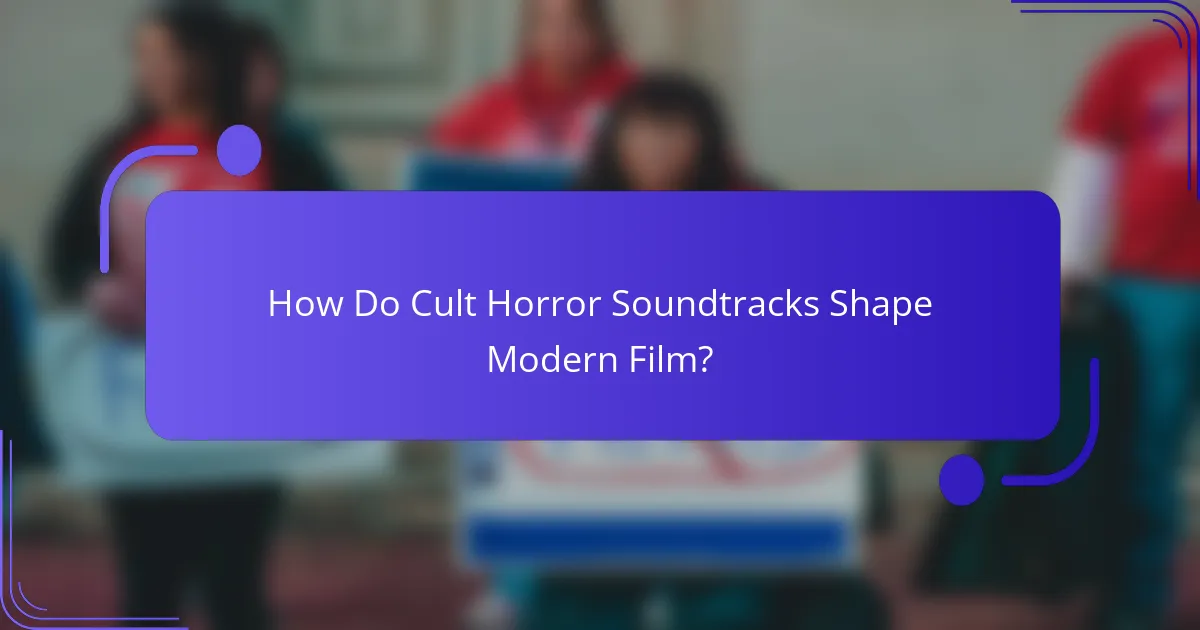
How Do Cult Horror Soundtracks Shape Modern Film?
Cult horror soundtracks significantly influence modern film by creating an immersive atmosphere that enhances storytelling. Their unique blend of eerie melodies and unsettling soundscapes not only sets the tone but also evokes strong emotional responses from audiences.
Revival of Retro Styles
The revival of retro styles in cult horror soundtracks often draws inspiration from the synth-heavy compositions of the 1980s. Films like “Stranger Things” and “It Follows” showcase how these nostalgic elements can create a sense of familiarity while simultaneously instilling fear. This trend encourages filmmakers to incorporate vintage sounds, making them appealing to both older and younger audiences.
Using analog synthesizers and vintage recording techniques can enhance the authenticity of the sound. Filmmakers should consider blending these retro styles with modern production methods to create a unique auditory experience that resonates with viewers.
Collaboration with Contemporary Artists
Collaborating with contemporary artists has become a popular strategy for infusing cult horror soundtracks with fresh perspectives. Artists like Rob Zombie and Trent Reznor have successfully merged their musical styles with horror themes, resulting in soundtracks that are both innovative and impactful. These partnerships can attract a broader audience and elevate the film’s cultural relevance.
Filmmakers should seek artists who align with the film’s vision and can contribute unique sounds. This approach not only enhances the score but also generates buzz around the film, as fans of the artists often become interested in the project.
Use in Marketing and Trailers
Soundtracks play a crucial role in marketing and trailers for cult horror films. A well-chosen score can create anticipation and set the mood, effectively drawing viewers in. For instance, the haunting melodies used in trailers can evoke curiosity and fear, compelling audiences to watch the film.
When selecting music for marketing, filmmakers should consider tracks that encapsulate the film’s essence while being memorable. Utilizing snippets of the soundtrack in promotional materials can enhance brand recognition and create a cohesive identity for the film.
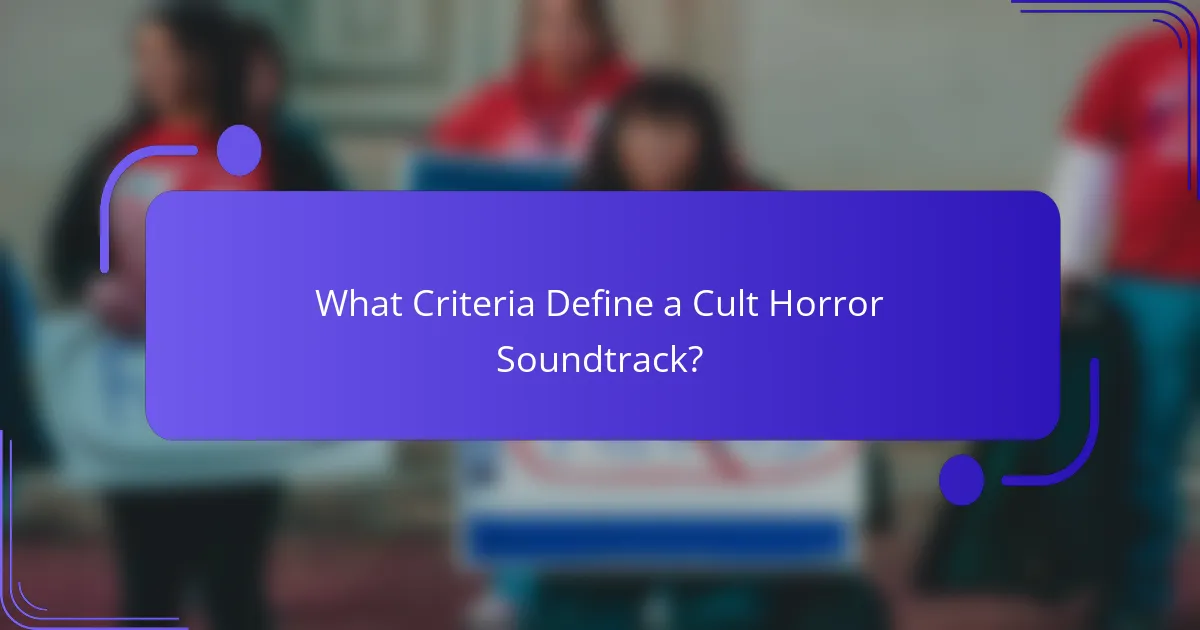
What Criteria Define a Cult Horror Soundtrack?
A cult horror soundtrack is characterized by its ability to evoke strong emotions, enhance the film’s atmosphere, and resonate with a dedicated audience. Key elements include unique instrumentation, innovative sound design, and memorable themes that contribute to the film’s identity and cultural significance.
Cultural Impact
The cultural impact of a cult horror soundtrack can be profound, often influencing other media and genres. Iconic scores, such as those from “Halloween” or “The Exorcist,” have permeated popular culture, leading to references in various forms of entertainment, including music, television, and even advertising.
These soundtracks frequently reflect societal fears and anxieties, making them relevant beyond their original context. Their ability to resonate with audiences often leads to a lasting legacy, as they are revisited and reinterpreted by new generations.
Fan Following
Cult horror soundtracks often cultivate a passionate fan base that actively engages with the music outside of the films. Fans may attend live performances, collect vinyl editions, or participate in online communities dedicated to discussing and sharing their favorite scores.
This dedicated following can amplify a soundtrack’s popularity, leading to merchandise opportunities and special releases. Fans often appreciate the artistry behind the music, recognizing composers like John Carpenter and Goblin for their innovative contributions to the genre.
Critical Acclaim
Many cult horror soundtracks receive critical acclaim for their creativity and impact on the genre. Critics often highlight the unique ways these scores enhance storytelling, with some even earning awards or nominations for their contributions to film.
Soundtracks that successfully blend various musical styles or utilize unconventional sounds tend to stand out. For instance, the eclectic mix of electronic and orchestral elements in “Suspiria” has garnered praise for its haunting quality, showcasing how innovative sound design can elevate a horror film’s atmosphere.
